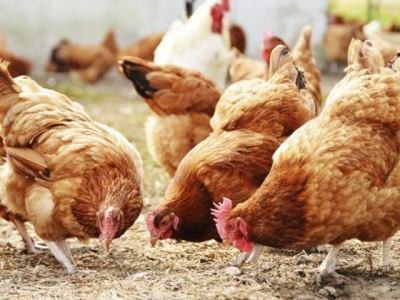Feed efficiency research in poultry has implications for human health

Birds with improved feed efficiency had better mitochondrial function that included less oxidative stress.
Poultry scientist Walter Bottje wanted to know what effect mitochondrial activity in chicken cells had on a bird's ability to convert food into muscle. That scientific curiosity set Bottje, professor of poultry physiology for the University of Arkansas System Division of Agriculture, on a complex path of discovery that means as much for human health as it does for the poultry industry.
Bottje's curiosity began with an interest in oxidative stress, an imbalance in cells caused by the overproduction of reactive oxygen species (ROS) — also known as oxidants. When this happens, there may not be enough antioxidants to neutralize them.
ROS molecules readily react with other molecules, like proteins, and cause damage to cells, Bottje said. Mutations caused by ROS are tied to many diseases, including cancer, aging, Alzheimer's disease, autism, obesity and diabetes.
Previous research in Bottje's lab indicated that oxidative stress was involved in pulmonary hypertension syndrome in poultry.
"ROS is like rust, corroding cell membranes, damaging proteins and even adversely affecting DNA," Bottje said. "Antioxidants act like Rustoleum, neutralizing the reactive molecules and preventing damage to cells."
A major site of oxidative stress in cells is in mitochondria, Bottje said. These organelles are a cell's power producers. They make 90% of a cell's adenosine triphosphate (ATP).
"A byproduct of the ATP production can be mitochondrial ROS formation that occurs when electrons get fumbled during ATP production," Bottje said. "They leak out of the transport system, mix with oxygen and form oxidants."
High amounts of ROS are damaging to the cell, Bottje said, but low levels of ROS are important in conveying information to the rest of cell. They initiate changes in expression of genes and proteins in a process called signal transduction. In this way, mitochondria are constantly communicating important information to the rest of the cell. This process helps the body's cells adjust to changing needs and conditions.
Feed efficiency tied to cellular functions
During investigations of feed efficiency, or how well food is converted into growth and meat production, Bottje's group was able to show that animals with higher efficiency had better mitochondrial function that included less mitochondrial ROS production and less oxidation of proteins. Initial work on this was facilitated and funded by Cobb-Vantress Inc. of Siloam Springs, Ark.
More recently, Bottje in collaboration with Byungwhi Kong and Sami Dridi in the poultry science department has been investigating global gene and protein expression in muscle. These studies are providing a picture of the basis of feed efficiency at the cellular level.
Oxidative stress turned out to be the first of many cellular activities affecting feed efficiency that Bottje has identified. "There are others, and we keep finding them," he said.
Discovering the causal agents of oxidative stress and locating gene markers that identify more efficient birds is important to poultry industry breeding programs, Bottje said. High feed efficiency with minimal health effects is critical to the poultry industry, especially in light of a need to grow more food for an expanding human population.
Implications for human health
Bottje's research on these cellular functions also helps discern the functions by which ROS and oxidative stress affect human health, he said. Chickens are a good model for understanding obesity in people. While feed efficiency is a good thing for chickens, it may not be so for people.
The broiler chickens he works with have been bred for such high feed efficiency that a baby chick that weighs 40-45 g when it hatches grows to 3,000 g in seven weeks. That's going from roughly 1.5 oz. to 6.6 lb. in 49 days. If people converted food to bodyweight at that rate, a 7 lb. newborn would weigh 450 lb. at seven weeks, Bottje said.
However, the chickens make a good model for people by studying the related cellular activity. Bottje said there are also similarities in lipid metabolism between chickens and people. Other animals are used as models for human obesity studies, he said, and chickens can help add a few more pieces to a very complex biological puzzle.
"The discoveries that we and other researchers are making help in the overall understanding of diabetes and other health issues," Bottje said. "We're adding to the foundation of knowledge about the causes of obesity that are important in solving the health problem."
Related news
 Finer grinding yeast supplements may boost broiler immunity, gut health
Finer grinding yeast supplements may boost broiler immunity, gut health Using a more finely ground yeast cell wall (YCW) feed supplement may boost immune functioning and gut health in broilers.
 Can cassava replace corn in poultry feed?
Can cassava replace corn in poultry feed? Replacing corn with cassava and reducing protein levels in poultry diets may offer sustainable production.
 Can yeast derived beta glucans improve the intestinal health of broilers?
Can yeast derived beta glucans improve the intestinal health of broilers? Adding yeast-based beta-glucans to poultry diets can boost growth performance, feed efficiency with disease challenge, finds study.